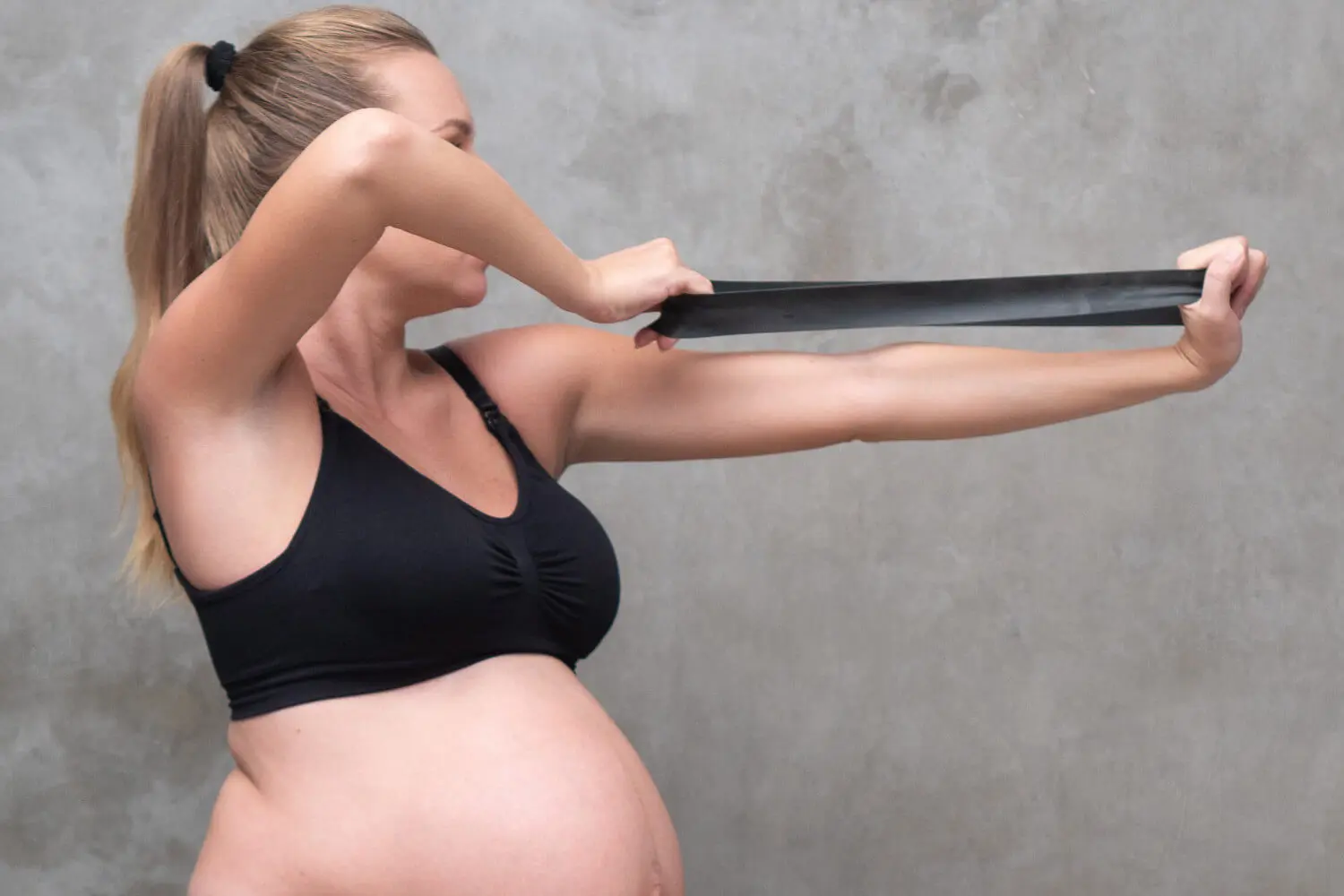The Keys to Firming Your Abdomen in the Postpartum Period

Looking firm after childbirth is a physical goal that many women fret about. However, firming your abdomen during the postpartum period has a lot to do with your lifestyle during both your pregnancy and the postpartum period, as well as certain medical conditions.
Logically, the growth of the belly to accommodate the baby leads to subsequent flabbiness. Some moms regain their figure in a short period of time. Others, however, face a process that can take months, where a combination of treatment and exercise is advisable.
Why is there abdominal flaccidity after childbirth?

In pregnancy, the skin of the belly undergoes distension, a product of the increase of adipose and connective tissues that increase the body volume, argues a publication of the Offarm magazine.
When the woman begins to recover, her body often faces disorders that sometimes make it difficult to return to her pre-pregnancy weight, as well as to the firmness of her abdomen.
It’s believed that a condition that influences this in certain cases is the diastasis of the rectus abdominis. According to research published in the British Journal of Sports Medicine, this is the separation of the rectus abdominis muscle.
Such a condition may occur in pregnancy or after childbirth. Diastasis of the rectus abdominis occurs when the tissues connecting the abdominal muscles weaken, causing a bulge. However, it’s not permanent damage. Physical therapy aids in recovery.
Like this article? We think you may also find this one interesting: Hypertension in Pregnancy: Everything You Need to Know
The importance of exercise during pregnancy
Contrary to what some people assume, absolute rest during pregnancy is not advisable unless it’s a high-risk pregnancy. As long as the gynecologist authorizes it, exercising at this stage brings benefits such as the following:
- It prevents excessive weight gain
- It minimizes back pain
- Exercising during pregnancy maintains muscle tone
- It promotes endurance and strength
- It promotes sleep
- Exercising during pregnancy lifts your spirits
- It reduces the chances of a cesarean section
In addition, exercise contributes to a positive pregnancy, and facilitates childbirth and the postpartum period, according to a report in the magazine Aghatos. If the woman maintains a good physical condition during pregnancy, there’s also a greater probability of simplifying the firmness of the abdomen afterward.
Recommendations for firming your abdomen in the postpartum period

Postpartum girdles are among the many alternatives to flatten the abdomen. However, wearing them is controversial because not all doctors approve of them. In view of the debate, in order for moms to regain their pre-birth image, the following suggestions should be put into practice.
Drink plenty of water
One of the main causes of postpartum abdominal flaccidity is fluid retention. Contrary to popular belief, drinking enough water decreases belly bloating. Make sure to drink at least 2 liters (over 6 to 8 glasses) of water a day.
Firming your abdomen with walking
A simple exercise such as walking combats belly flab after giving birth. Dedicate 20 minutes to a walk, even if it’s indoors, and you will see how you control fluid retention in both the abdomen and legs. As time goes by, if possible, switch to jogging or any other aerobic activity.
Moisturize the skin
The postpartum abdomen needs intense hydration to tone the muscles. Creams and oils favor the restructuring of the skin. Lotions with shea, jojoba, argan and sweet almond oils are alternatives for firming excess skin in the postpartum period.
Firming your abdomen: Eating healthy
Eating during and after pregnancy must be balanced. Eating healthy and balanced food prevents fluid retention and stimulates the muscles. Include fruits, green leafy vegetables, cereals, and foods containing Omega 3 in your menu.
Breastfeeding
Breastfeeding contributes to the process of regaining your figure. The Johnson’s® Newborn Care Guide highlights that breastfeeding the baby extracts electrolytes and nutritional substances through breast milk, causing you to lose weight. By losing size with this natural process, you accelerate the decrease in abdominal volume.
We think you may also like to read this article: How to Treat Cystitis During Pregnancy with Home Remedies
Practice yoga
Disciplines that involve deep breathing and that engage the abdomen are excellent options to correct your posture, release stress, and shape your body. Yoga and Pilates stand out among the alternatives. Merge these methods with some aerobic exercises, and little by little, you will notice the changes.
Perform hypopressive crunches
Among the most talked-about alternatives to tone the abdomen after giving birth are hypopressive crunches. This dynamic is based on the rhythmic practice of different postures and respiratory apnea to recover the condition of the pelvic floor and abdomen.
You should only do hypopressive exercises after having them authorized by your doctor.
Try the Tupler technique
The Tupler technique firms the abdomen if it’s linked to a diagnosis of diastasis. This technique consists of routines that mix deep breathing and movements to contract and lift the transverse muscles in the area. The creator of the technique, Julie Tupler, suggests repeating the exercises several times a day.
Patience is the key to firming your abdomen in the postpartum period
Apart from all the suggested methods, patience is essential to recover the firmness of your belly after pregnancy. Some mothers don’t make such an effort, but if you do, remember that the abdomen is a delicate area and requires time to recover
Although there are quick ways, such as cosmetic surgeries, don’t lose sight of the fact that you can achieve a flat abdomen with peace and a little discipline without resorting to an invasive procedure.
All cited sources were thoroughly reviewed by our team to ensure their quality, reliability, currency, and validity. The bibliography of this article was considered reliable and of academic or scientific accuracy.
- Bakken Sperstad J, Bø K, Ellström-Engh M, Hilde G, Kolberg Tennfjord M. Diástasis de rectos abdominales durante el embarazo y 12 meses después del parto: prevalencia, factores de riesgo y reportes de dolor lumbopélvico. Revista Británica de Medicina Deportiva. Vol. 50. Núm. 17. Reino Unido; 2016. https://bjsm.bmj.com/content/50/17/1092
- Font E. Cuidado de la piel en el embarazo y en el postparto. Offarm. Vol. 22. Núm. 2. España; 2003. https://www.elsevier.es/es-revista-offarm-4-articulo-cuidado-piel-el-embarazo-el-13043198
- Luque López E, Muros Naranjo M, Sánchez Pascual M. Aspectos beneficiosos del ejercicio físico en el embarazo. Agathos. Vol. 18. Núm. 2. pp38-44. España; 2018. https://www.mendeley.com/catalogue/74ac6822-74f6-391a-980b-99b6dc086e1d/?utm_source=desktop&utm_medium=1.19.4&utm_campaign=open_catalog&userDocumentId=%7Bc5a8b06b-57c5-487e-b903-61ad73e519c8%7D
- Torres Muñoz J. Guía de Cuidados del Recién Nacido Johnson’s®. Johnson’s®. Colombia; 2020. https://www.johnsonsbaby.com.co/por-que-la-lactancia-adelgaza#:~:text=%E2%80%9CEl%20mecanismo%20con%20el%20cu%C3%A1l,un%20poco%20de%20peso%2C%20eso
- Tupler J. Tupler Technique. Estados Unidos. https://diastasisrehab.com/pages/diastasis-the-tupler-technique
This text is provided for informational purposes only and does not replace consultation with a professional. If in doubt, consult your specialist.








